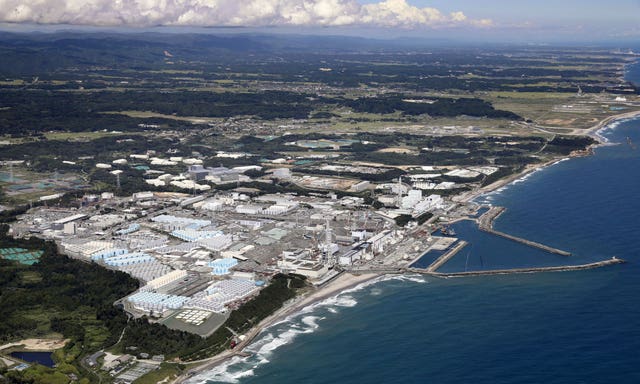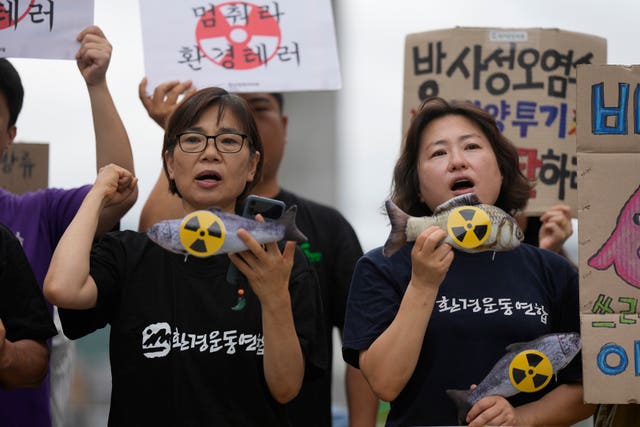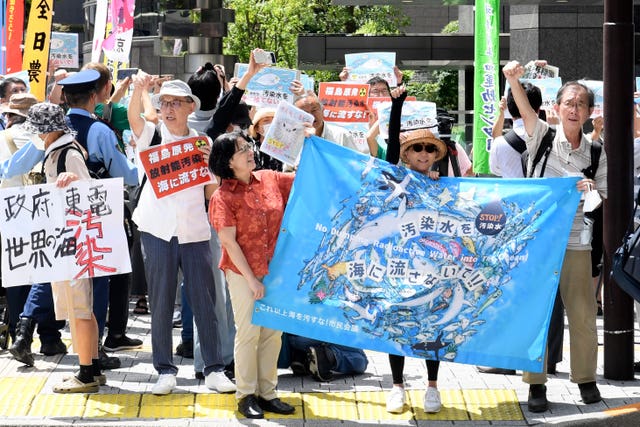The operator of the tsunami-wrecked Fukushima Daiichi nuclear power plant says it has begun releasing a first batch of treated radioactive water into the Pacific Ocean – a controversial step that prompted China to ban seafood from Japan.
A live video from a control room at the plant on Thursday showed a Tokyo Electric Power Company Holdings (TEPCO) staff member turn on a seawater pump, marking the beginning of the controversial project that is expected to last for decades.
“Seawater pump A activated,” the main operator said, confirming the release was underway.
Japanese fishing groups have opposed the plan due to concerns over further damage to the reputation of their seafood. Groups in China and South Korea have also raised concern.

In response to the release, Chinese customs authorities banned seafood from Japan, customs authorities announced.
The ban started immediately and will affect all imports of “aquatic products” including seafood, according to the notice.
Authorities said they will “dynamically adjust relevant regulatory measures as appropriate to prevent the risks of nuclear-contaminated water discharge to the health and food safety of our country”.
Shortly after China’s announcement, TEPCO president Tomoaki Kobayakawa said the utility was preparing to compensate Japanese business owners appropriately for damages suffered by export bans from “the foreign government” over the wastewater release.
He said China is Japan’s key trading partner and that he will do his utmost by providing scientific explanations of the release so that the ban will be dropped as soon as possible.
But the Japanese government and TEPCO say the water must be released to make room for the plant’s decommissioning and to prevent accidental leaks.
They say the treatment and dilution will make the wastewater safer than international standards and its environmental impact will be negligibly small. But some scientists say long-term impact of the low-dose radioactivity that remains in the water needs attention.

The water release begins more than 12 years after the March 2011 nuclear meltdowns, caused by a massive earthquake and tsunami. It marks a milestone for the plant’s battle with an ever-growing radioactive water stockpile that TEPCO and the government say have hampered the daunting task of removing the fatally toxic melted debris from the reactors.
The pump activated on Thursday afternoon would send the first batch of the diluted, treated water from a mixing pool to a secondary pool, where the water is then discharged into the ocean through an undersea tunnel.
The water is collected and partly recycled as cooling water after treatment with the rest stored in around 1,000 tanks, which are already filled to 98% of their 1.37-million-ton capacity.
Those tanks, which cover much of the plant complex, must be freed up to build the new facilities needed for the decommissioning process, officials said.
Prime Minister Fumio Kishida said it is indispensable and cannot be postponed. He noted an experimental removal of a small amount of the melted debris from the Number 2 reactor is set for later this year using a remote-controlled giant robotic arm.
TEPCO executive Junichi Matsumoto said the release was beginning with the least radioactive water to ensure safety.

Final preparation for the release began on Tuesday, when just one ton of treated water was sent from a tank for dilution with 1,200 tons of seawater, and the mixture was kept in the primary pool for two days for final sampling to ensure safety, Mr Matsumoto said.
A batch of 460 tons was to be sent to the mixing pool on Thursday for the actual discharge.
Fukushima’s current fish catch is only about one-fifth its pre-disaster level, in part due to a decline in the fishing population.
China has tightened radiation testing on Japanese products from Fukushima and nine other prefectures, halting exports at customs for weeks, Fisheries Agency officials said.
You may also like; UK’s biggest oil and gas producer Harbour Energy reports £337m profit

